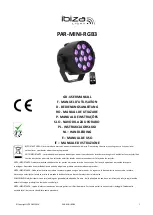
Programming Manual MSO/UPO2000 Series
116 / 156
Instruments.uni-trend.com
<voltage> represents voltage, unit is assigned by the current channel.
<n>: channel number, n take value from 1, 2.
Return format
:
Query returns output low level of the specified channel signal in scientific notation.
For example
:
AWG:CHANnel1:BASE:LOW 2
Set output low value of channel 1 signal to 2 V.
AWG:CHANnel1:BASE:LOW?
Query returns 2e+0.
AWG:CHANnel<n>:BASE:DUTY
Command format
:
AWG:CHANnel<n>:BASE:DUTY <duty>
AWG:CHANnel<n>:BASE:DUTY?
Functional description
:
This command is used to set output duty cycle of the specified channel signal.
<duty> represents duty cycle, unit is %. The range is 0~100.
<n>: channel number, n take value from 1, 2.
Return format
:
Query returns output duty cycle of the specified channel signal.
For example
:
AWG:CHANnel1:BASE:DUTY 20
Set output duty cycle of channel 1 signal to 20%.
AWG:CHANnel1:BASE:DUTY?
Query returns 20.
AWG:CHANnel<n>:RAMP:SYMMetry
Command format
:
AWG:CHANnel<n>:RAMP:SYMMetry <symmetry>
AWG:CHANnel<n>:RAMP:SYMMetry?
Functional description
:
This command is used to set output symmetry degree of the specified channel ramp signal.
< symmetry > represents symmetry degree, unit is %. The range is 0~100.
<n>: channel number, n take value from 1, 2.
Return format
:
Query returns output symmetry degree of the specified ramp signal.
For example
:
AWG:CHANnel1:RAMP:SYMMetry 20
Set symmetry degree of channel 1 ramp signal to 20%.
AWG:CHANnel1:RAMP:SYMMetry?
Query returns 20.
AWG:CHANnel<n>:
PULSe:
RISe
Command format
:
















































